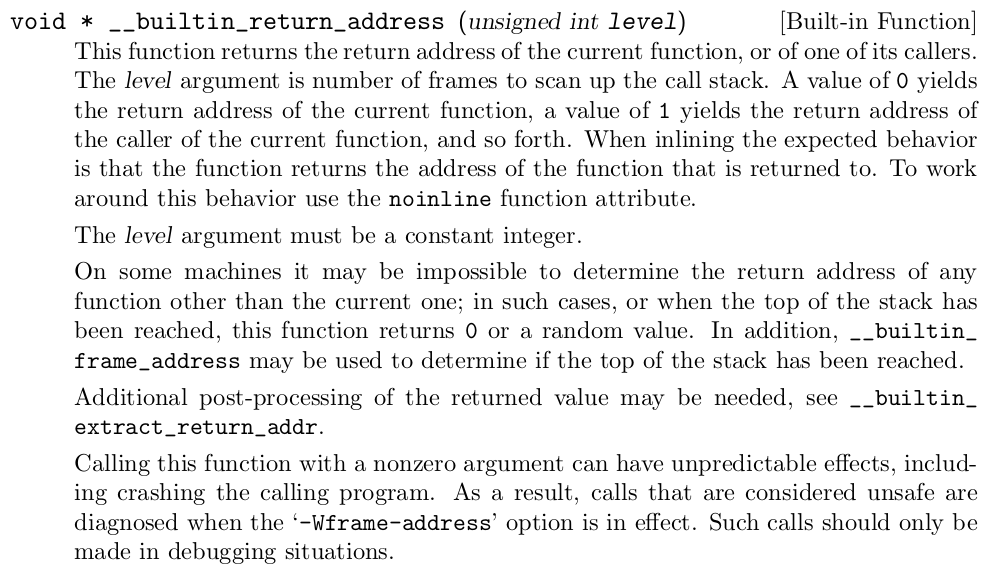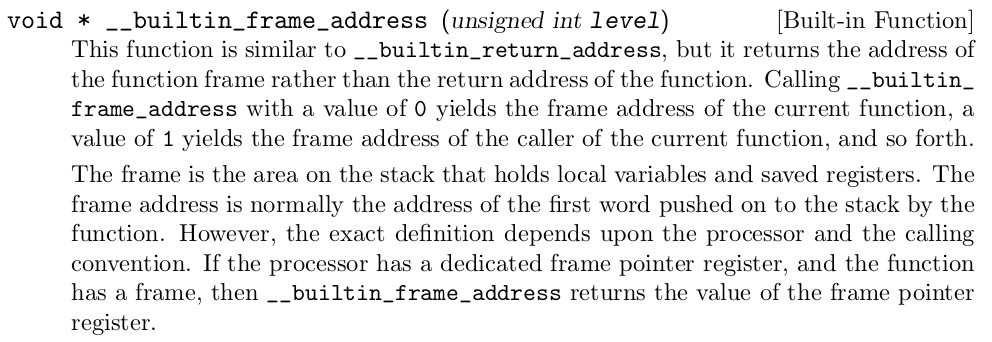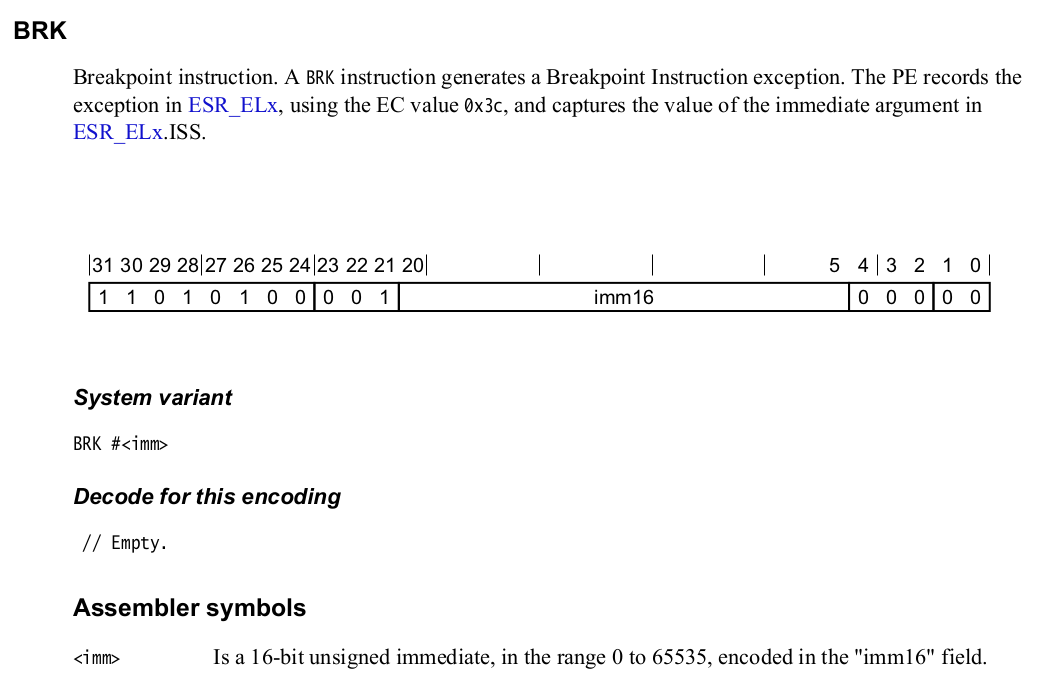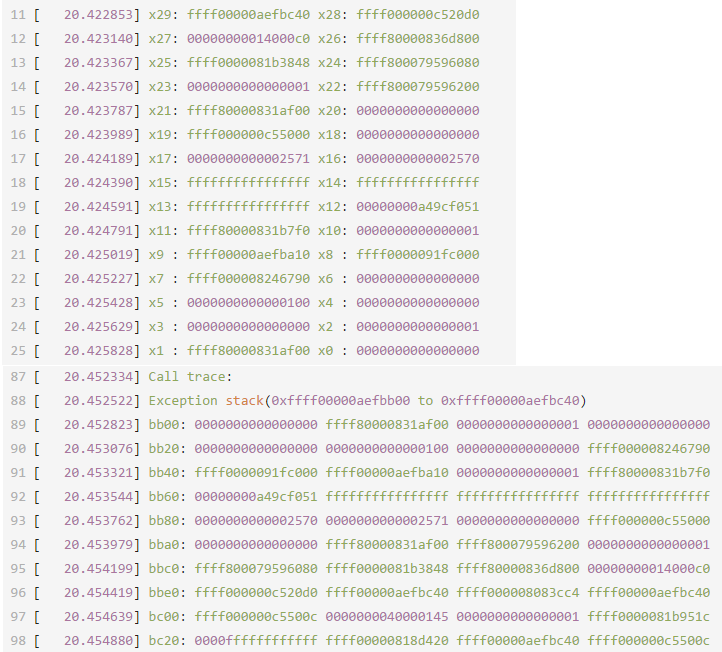内核中dump_stack的实现原理(1) —— 栈回溯
环境
Aarch64
Qemu
aarch64-linux-gnu-gcc
linux-4.14
概述
栈回溯的目的是将函数的调用栈打印出来,对于分析函数调用和debug系统异常会很有帮助。对于Aarch64,x29用于用来当做帧指针,x30用来存放函数返回地址。
正文
原理
首先通过一个简单的程序分析一下栈回溯的原理,下面是测试程序:
1 #include <stdio.h> 2 3 int func3(int b) 4 { 5 int a = 10; 6 printf("a = %d\n", a + b); 7 return a; 8 } 9 10 int func2(int d) 11 { 12 int b; 13 14 b = func3(d); 15 printf("b = %d\n", b + d); 16 return b; 17 } 18 19 int func1(int a) 20 { 21 int d; 22 23 d = func2(a); 24 printf("d = %d\n", d); 25 return d; 26 } 27 28 int main(int argc, const char *argv[]) 29 { 30 int a = 10; 31 32 func1(a); 33 return 0; 34 }
然后我们对其进行编译和反汇编:
aarch64-linux-gnu-gcc a.c -o main
aarch64-linux-gnu-objdump -D main > main.S
下面是main.S文件:
1 000000000040055c <func3>: 2 40055c: a9bd7bfd stp x29, x30, [sp, #-48]! 3 400560: 910003fd mov x29, sp 4 400564: b9001fa0 str w0, [x29, #28] 5 400568: 52800140 mov w0, #0xa // #10 6 40056c: b9002fa0 str w0, [x29, #44] 7 400570: b9402fa1 ldr w1, [x29, #44] 8 400574: b9401fa0 ldr w0, [x29, #28] 9 400578: 0b000021 add w1, w1, w0 10 40057c: 90000000 adrp x0, 400000 <_init-0x3e8> 11 400580: 911b8000 add x0, x0, #0x6e0 12 400584: 97ffffb3 bl 400450 <printf@plt> 13 400588: b9402fa0 ldr w0, [x29, #44] 14 40058c: a8c37bfd ldp x29, x30, [sp], #48 15 400590: d65f03c0 ret 16 17 0000000000400594 <func2>: 18 400594: a9bd7bfd stp x29, x30, [sp, #-48]! 19 400598: 910003fd mov x29, sp 20 40059c: b9001fa0 str w0, [x29, #28] 21 4005a0: b9401fa0 ldr w0, [x29, #28] 22 4005a4: 97ffffee bl 40055c <func3> 23 4005a8: b9002fa0 str w0, [x29, #44] 24 4005ac: b9402fa1 ldr w1, [x29, #44] 25 4005b0: b9401fa0 ldr w0, [x29, #28] 26 4005b4: 0b000021 add w1, w1, w0 27 4005b8: 90000000 adrp x0, 400000 <_init-0x3e8> 28 4005bc: 911ba000 add x0, x0, #0x6e8 29 4005c0: 97ffffa4 bl 400450 <printf@plt> 30 4005c4: b9402fa0 ldr w0, [x29, #44] 31 4005c8: a8c37bfd ldp x29, x30, [sp], #48 32 4005cc: d65f03c0 ret 33 34 00000000004005d0 <func1>: 35 4005d0: a9bd7bfd stp x29, x30, [sp, #-48]! 36 4005d4: 910003fd mov x29, sp 37 4005d8: b9001fa0 str w0, [x29, #28] 38 4005dc: b9401fa0 ldr w0, [x29, #28] 39 4005e0: 97ffffed bl 400594 <func2> 40 4005e4: b9002fa0 str w0, [x29, #44] 41 4005e8: 90000000 adrp x0, 400000 <_init-0x3e8> 42 4005ec: 911bc000 add x0, x0, #0x6f0 43 4005f0: b9402fa1 ldr w1, [x29, #44] 44 4005f4: 97ffff97 bl 400450 <printf@plt> 45 4005f8: b9402fa0 ldr w0, [x29, #44] 46 4005fc: a8c37bfd ldp x29, x30, [sp], #48 47 400600: d65f03c0 ret 48 49 0000000000400604 <main>: 50 400604: a9bd7bfd stp x29, x30, [sp, #-48]! 51 400608: 910003fd mov x29, sp 52 40060c: b9001fa0 str w0, [x29, #28] 53 400610: f9000ba1 str x1, [x29, #16] 54 400614: 52800140 mov w0, #0xa // #10 55 400618: b9002fa0 str w0, [x29, #44] 56 40061c: b9402fa0 ldr w0, [x29, #44] 57 400620: 97ffffec bl 4005d0 <func1> 58 400624: 52800000 mov w0, #0x0 // #0 59 400628: a8c37bfd ldp x29, x30, [sp], #48 60 40062c: d65f03c0 ret
main:
第50行,将main函数的返回地址和上级函数的栈底存入main函数的栈底,剩余的main栈用于存放main的局部变量
第59行,执行完毕后,x30中存放的是main的返回地址,x29指向的是上一级函数的栈底
func1:
第35行,将func1函数的返回地址和main函数的栈底存入func1函数的栈底,剩余的func1栈用于存放func1的局部变量
第46行,执行完毕后,x30中存放的是func1的返回地址,即第58行,x29指向的是main函数的栈底
func2:
第18行,将func2函数的返回地址和func1函数的栈底存入func2函数的栈底,剩余的func2栈用于存放func2的局部变量
第31行,执行完毕后,x30中存放的是func2的返回地址,即第40行,x29指向的是func1函数的栈底
func3:
第2行,将func3函数的返回地址func3函数的栈底,剩余的func3栈用于存放func3的局部变量
第14行,执行完毕后,x30中存放的是func3的返回地址,即第23行,x29指向的是func2函数的栈底
最终可以得到下面的示意图:

所以,在函数func3中,就可以通过上面的结构就可以从func3回溯到main函数。
gcc提供了编译选项-fomit-frame-pointer和-fno-omit-frame-pointer,如果在编译时指定了-fno-omit-frame-pointer,那么就没有帧指针了,所以也就无法进行栈回溯了,默认有帧指针。
使用API进行栈回溯
在用户空间提供了回溯用的API:
#include <execinfo.h> int backtrace(void **buffer, int size); char **backtrace_symbols(void *const *buffer, int size);
在func3使用上面的两个函数回溯一下:
1 #include <execinfo.h> 2 3 int func3(int b) 4 { 5 int a = 10, n, i; 6 void *buffer[10]; 7 char **strings; 8 9 n = backtrace(buffer, 10); 10 strings = backtrace_symbols(buffer, n); 11 12 for (i = 0; i < n; i++) 13 printf("%s\n", strings[i]); 14 15 printf("a = %\n", a + b); 16 17 return a; 18 }
编译:
aarch64-linux-gnu-gcc -funwind-tables -rdynamic -O0 -g a.c -o main
运行:
[root@aarch64 ~]# ./main ./main(func3+0x20) [0x400a1c] ./main(func2+0x14) [0x400aa4] ./main(func1+0x14) [0x400ae0] ./main(main+0x20) [0x400b20] /lib/libc.so.6(__libc_start_main+0xec) [0xffffb8d732c8] a = 20 b = 20 d = 10
使用内敛汇编进行栈回溯
如果不使用上面的API的话,也可以用访问寄存器的方式来完成:
1 #include <execinfo.h> 2 3 typedef struct { 4 unsigned long x29; 5 unsigned long x30; 6 } node_t; 7 8 void back(void) 9 { 10 node_t *addr; 11 12 printf("\nBackstrace not use api:\n"); 13 14 asm volatile("mov %0, x29\n\t":"=r"(addr)::); 15 while(addr && addr->x30 && addr->x29) { 16 printf("\t%p\n", addr->x30); 17 addr = (node_t *)addr->x29; 18 } 19 } 20 21 int func3(int b) 22 { 23 int a = 10, n, i; 24 void *buffer[10]; 25 char **strings; 26 27 n = backtrace(buffer, 10); 28 strings = backtrace_symbols(buffer, n); 29 30 printf("\nBackstrace use api:\n"); 31 for (i = 0; i < n; i++) 32 printf("\t%s\n", strings[i]); 33 34 back(); 35 36 printf("a = %d\n", a + b); 37 return a; 38 }
使用GCC的内部函数进行栈回溯
gcc提供了两个内置的函数用来获取函数的返回地址和帧指针的值:



下面用这两个宏实现以下回溯:
1 #include <execinfo.h>
2
3 typedef struct {
4 unsigned long x29;
5 unsigned long x30;
6 } node_t;
7
8 void back(void)
9 {
10 node_t *addr;
11
12 printf("\nBackstrace not use api:\n");
13
14 asm volatile("mov %0, x29\n\t":"=r"(addr)::);
15 while(addr && addr->x30 && addr->x29) {
16 printf("\t%p\n", addr->x30);
17 addr = (node_t *)addr->x29;
18 }
19 }
20
21 void back_builtin(void)
22 {
23 node_t *addr;
24
25 printf("\nBackstrace using builtin func:\n");
26
27 printf("the return address of back_builtin: %p\n",
28 __builtin_return_address(0));
29 addr = __builtin_frame_address(0);
30 while(addr && addr->x30 && addr->x29) {
31 printf("\t%p\n", addr->x30);
32 addr = (node_t *)addr->x29;
33 }
34 }
35
36 int func3(int b)
37 {
38 int a = 10, n, i;
39 void *buffer[10];
40 char **strings;
41
42 n = backtrace(buffer, 10);
43 strings = backtrace_symbols(buffer, n);
44
45 printf("\nBackstrace use api:\n");
46 for (i = 0; i < n; i++)
47 printf("\t%s\n", strings[i]);
48
49 back();
50
51 back_builtin();
52
53 printf("a = %d\n", a + b);
54 return a;
55 }
运行结果:
[root@aarch64 ~]# ./main Backstrace use api: ./main(func3+0x20) [0x400b74] ./main(func2+0x14) [0x400c18] ./main(func1+0x14) [0x400c54] ./main(main+0x20) [0x400c94] /lib/libc.so.6(__libc_start_main+0xec) [0xffffb92632c8] Backstrace not use api: 0x400bdc 0x400c18 0x400c54 0x400c94 0xffffb92632c8 Backstrace using builtin func: the return address of back_builtin: 0x400be0 0x400be0 0x400c18 0x400c54 0x400c94 0xffffb92632c8 a = 20 b = 20 d = 10
不使用API进行栈回溯的缺点是只能打印出地址,但是却无法打印出具体的符号名字。
内核的栈回溯
在Linux内核中可以使用WARN_ON还输出当前的函数调用栈。下面是一个测试程序输出的log:
[ 20.419376] ------------[ cut here ]------------ [ 20.420062] WARNING: CPU: 0 PID: 1115 at /home/pengdonglin/disk_ext/Qemu/aarch64/demo_driver/demo.c:35 demo_init+0xc/0x1000 [demo] [ 20.420546] Modules linked in: demo(O+) [ 20.421004] CPU: 0 PID: 1115 Comm: insmod Tainted: G O 4.14.92-ga06114e5 #3 [ 20.421371] Hardware name: linux,dummy-virt (DT) [ 20.421600] task: ffff80000831af00 task.stack: ffff00000aef8000 [ 20.421899] PC is at demo_init+0xc/0x1000 [demo] [ 20.422142] LR is at do_one_initcall+0x44/0x130 [ 20.422360] pc : [<ffff000000c5500c>] lr : [<ffff000008083cc4>] pstate: 40000145 [ 20.422657] sp : ffff00000aefbc40 [ 20.422853] x29: ffff00000aefbc40 x28: ffff000000c520d0 [ 20.423140] x27: 00000000014000c0 x26: ffff80000836d800 [ 20.423367] x25: ffff0000081b3848 x24: ffff800079596080 [ 20.423570] x23: 0000000000000001 x22: ffff800079596200 [ 20.423787] x21: ffff80000831af00 x20: 0000000000000000 [ 20.423989] x19: ffff000000c55000 x18: 0000000000000000 [ 20.424189] x17: 0000000000002571 x16: 0000000000002570 [ 20.424390] x15: ffffffffffffffff x14: ffffffffffffffff [ 20.424591] x13: ffffffffffffffff x12: 00000000a49cf051 [ 20.424791] x11: ffff80000831b7f0 x10: 0000000000000001 [ 20.425019] x9 : ffff00000aefba10 x8 : ffff0000091fc000 [ 20.425227] x7 : ffff000008246790 x6 : 0000000000000000 [ 20.425428] x5 : 0000000000000100 x4 : 0000000000000000 [ 20.425629] x3 : 0000000000000000 x2 : 0000000000000001 [ 20.425828] x1 : ffff80000831af00 x0 : 0000000000000000 [ 20.426106] [ 20.426106] X1: 0xffff80000831ae80: [ 20.426292] ae80 00000000 00000000 00000000 00000000 00000000 00000000 00000000 00000000 [ 20.426774] aea0 00000000 00000000 00000000 00000000 00000000 00000000 00000000 00000000 [ 20.427177] aec0 00000000 00000000 00000000 00000000 00000000 00000000 00000000 00000000 [ 20.427568] aee0 00000000 00000000 00000000 00000000 00000000 00000000 00000000 00000000 [ 20.427973] af00 00000020 00000000 ffffffff ffffffff 00000000 00000000 00000000 00000000 [ 20.428389] af20 0aef8000 ffff0000 00000002 00400100 00000000 00000000 00000000 00000000 [ 20.428899] af40 00000001 00000000 00000007 00000000 fffeee58 00000000 7c082f00 ffff8000 [ 20.429415] af60 00000000 00000001 00000078 00000078 00000078 00000000 08c60b88 ffff0000 [ 20.429962] [ 20.429962] X11: 0xffff80000831b770: [ 20.430199] b770 00000000 00000000 00000000 00000000 00000000 00000000 00000000 00000000 [ 20.430706] b790 00000000 00000000 00000a50 00000000 082c2790 ffff0000 080816dc ffff0000 [ 20.431223] b7b0 00000a4f 00000a50 00000000 00000000 080ed6bc ffff0000 08081f18 ffff0000 [ 20.431743] b7d0 00000989 000009b8 00000001 00000000 00000000 00000000 00000000 00000000 [ 20.432262] b7f0 00000000 00000000 08175f18 ffff0000 09198b88 ffff0000 00000000 00000000 [ 20.432779] b810 000c0001 00000000 683da59d 64dfae01 08175c7c ffff0000 09198b88 ffff0000 [ 20.433297] b830 00000000 00000000 000c0001 00000000 4ccad968 18f18caf 08175e48 ffff0000 [ 20.433813] b850 09198cb8 ffff0000 00000000 00000000 000c0005 00000000 e69cf65f 335c3458 [ 20.434334] [ 20.434334] X21: 0xffff80000831ae80: [ 20.434561] ae80 00000000 00000000 00000000 00000000 00000000 00000000 00000000 00000000 [ 20.435073] aea0 00000000 00000000 00000000 00000000 00000000 00000000 00000000 00000000 [ 20.435598] aec0 00000000 00000000 00000000 00000000 00000000 00000000 00000000 00000000 [ 20.436228] aee0 00000000 00000000 00000000 00000000 00000000 00000000 00000000 00000000 [ 20.436756] af00 00000020 00000000 ffffffff ffffffff 00000000 00000000 00000000 00000000 [ 20.437271] af20 0aef8000 ffff0000 00000002 00400100 00000000 00000000 00000000 00000000 [ 20.437789] af40 00000001 00000000 00000007 00000000 fffeee58 00000000 7c082f00 ffff8000 [ 20.438466] af60 00000000 00000001 00000078 00000078 00000078 00000000 08c60b88 ffff0000 [ 20.439138] [ 20.439138] X22: 0xffff800079596180: [ 20.439386] 6180 746f6e2e 6e672e65 75622e75 2d646c69 00006469 00000000 00000000 00000000 [ 20.440006] 61a0 00000000 00000000 00000000 00000000 00000000 00000000 00000000 00000000 [ 20.440529] 61c0 00000000 00000000 00000000 00000000 00000000 00000000 00000000 00000000 [ 20.441098] 61e0 00000000 00000000 00000000 00000000 00000000 00000000 00000000 00000000 [ 20.441608] 6200 79596480 ffff8000 6f6d6564 00000000 00c55000 ffff0000 00000000 00000000 [ 20.442065] 6220 00000000 00000000 00000000 00000000 00000000 00000000 00000000 00000000 [ 20.442529] 6240 00000000 00000000 00000000 00000000 00000000 00000000 00000000 00000000 [ 20.443078] 6260 00000000 00000000 00000000 00000000 00000000 00000000 00000000 00000000 [ 20.443652] [ 20.443652] X24: 0xffff800079596000: [ 20.443856] 6000 7274732e 00626174 00000000 00000000 00000000 00000000 00000000 00000000 [ 20.444321] 6020 00000000 00000000 00000000 00000000 00000000 00000000 00000000 00000000 [ 20.444809] 6040 00000000 00000000 00000000 00000000 00000000 00000000 00000000 00000000 [ 20.445273] 6060 00000000 00000000 00000000 00000000 00000000 00000000 00000000 00000000 [ 20.445707] 6080 79596100 ffff8000 00000001 00000000 7a34a700 ffff8000 00000124 00000000 [ 20.446208] 60a0 09e94940 ffff0000 00000000 00000000 00000024 00000000 00c51000 ffff0000 [ 20.446775] 60c0 081b3720 ffff0000 00000000 00000000 00000000 00000000 00000000 00000000 [ 20.447339] 60e0 00000000 00000000 00000000 00000000 00000000 00000000 00000000 00000000 [ 20.447919] [ 20.447919] X26: 0xffff80000836d780: [ 20.448134] d780 00000000 00000000 00000000 00000000 00000000 00000000 00000000 00000000 [ 20.448637] d7a0 00000000 00000000 00000000 00000000 00000000 00000000 00000000 00000000 [ 20.449144] d7c0 00000000 00000000 00000000 00000000 00000000 00000000 00000000 00000000 [ 20.449641] d7e0 00000000 00000000 00000000 00000000 00000000 00000000 00000000 00000000 [ 20.450148] d800 08eee848 ffff0000 00000000 00000000 00000000 00000000 0836dca8 ffff8000 [ 20.450646] d820 00000000 00000000 0000000d 00000000 7a34a700 ffff8000 00000124 00000000 [ 20.451149] d840 09e94938 ffff0000 00000000 00000000 081b3848 ffff0000 00000000 00000000 [ 20.451652] d860 00000000 00000000 00000000 00000000 00000000 00000000 7a34a700 ffff8000 [ 20.452138] [ 20.452334] Call trace: [ 20.452522] Exception stack(0xffff00000aefbb00 to 0xffff00000aefbc40) [ 20.452823] bb00: 0000000000000000 ffff80000831af00 0000000000000001 0000000000000000 [ 20.453076] bb20: 0000000000000000 0000000000000100 0000000000000000 ffff000008246790 [ 20.453321] bb40: ffff0000091fc000 ffff00000aefba10 0000000000000001 ffff80000831b7f0 [ 20.453544] bb60: 00000000a49cf051 ffffffffffffffff ffffffffffffffff ffffffffffffffff [ 20.453762] bb80: 0000000000002570 0000000000002571 0000000000000000 ffff000000c55000 [ 20.453979] bba0: 0000000000000000 ffff80000831af00 ffff800079596200 0000000000000001 [ 20.454199] bbc0: ffff800079596080 ffff0000081b3848 ffff80000836d800 00000000014000c0 [ 20.454419] bbe0: ffff000000c520d0 ffff00000aefbc40 ffff000008083cc4 ffff00000aefbc40 [ 20.454639] bc00: ffff000000c5500c 0000000040000145 0000000000000001 ffff0000081b951c [ 20.454880] bc20: 0000ffffffffffff ffff00000818d420 ffff00000aefbc40 ffff000000c5500c [ 20.455190] [<ffff000000c5500c>] demo_init+0xc/0x1000 [demo] [ 20.455419] [<ffff000008083cc4>] do_one_initcall+0x44/0x130 [ 20.455645] [<ffff0000081b9548>] do_init_module+0x64/0x1d4 [ 20.455859] [<ffff0000081b809c>] load_module+0x1e1c/0x24f0 [ 20.456096] [<ffff0000081b88f0>] SyS_init_module+0x180/0x218 [ 20.456299] Exception stack(0xffff00000aefbec0 to 0xffff00000aefc000) [ 20.456522] bec0: 0000ffffa3ec4010 000000000003b850 00000000005cad68 0000000000000000 [ 20.456776] bee0: 00000000ffffffff 0000000000000000 000000001bd34680 00000000005e2bf8 [ 20.457026] bf00: 0000000000000069 00000000005e4dc0 0000000000000003 0101010101010101 [ 20.457288] bf20: 0000000000000038 0000000000000001 00000000005e9000 00000000005e3000 [ 20.457539] bf40: 0000000000000000 0000000000000001 0000000000000000 0000000000000000 [ 20.457791] bf60: 0000000000000069 0000fffff0d52878 0000000000000008 0000fffff0d52880 [ 20.458052] bf80: 0000fffff0d52888 00000000005cad68 00000000005b9b24 0000000000000000 [ 20.458295] bfa0: 0000000000000000 0000fffff0d52720 000000000045bc74 0000fffff0d52440 [ 20.458546] bfc0: 0000000000409bf8 0000000040000000 0000ffffa3ec4010 0000000000000069 [ 20.458776] bfe0: 0000000000000000 0000000000000000 0000000000000000 0000000000000000 [ 20.459002] [<ffff000008083ac0>] el0_svc_naked+0x34/0x38 [ 20.459211] ---[ end trace 1d225ceb44d51601 ]---
分析:
include/asm-generic/bug.h: #define WARN_ON(condition) ({ \ int __ret_warn_on = !!(condition); \ if (unlikely(__ret_warn_on)) \ __WARN(); \ unlikely(__ret_warn_on); \ })
当给WARN_ON传递非0的参数时,就会调用__WARN()打印栈:
1 // 定义在include/asm-generic/bug.h中 2 #define __WARN() __WARN_TAINT(TAINT_WARN) // TAINT_WARN是9 3 #define __WARN_TAINT(taint) __WARN_FLAGS(BUGFLAG_TAINT(taint)) 4 5 // 定义在arch/arm64/include/asm/bug.h中 6 #define __WARN_FLAGS(flags) __BUG_FLAGS(BUGFLAG_WARNING|(flags)) // flags是0x900 7 #define __BUG_FLAGS(flags) \ 8 asm volatile (__stringify(ASM_BUG_FLAGS(flags))); // flags是0x901 9 10 #define _BUGVERBOSE_LOCATION(file, line) __BUGVERBOSE_LOCATION(file, line) 11 #define __BUGVERBOSE_LOCATION(file, line) \ 12 .pushsection .rodata.str,"aMS",@progbits,1; \ 13 2: .string file; \ 14 .popsection; \ 15 \ 16 .long 2b - 0b; \ 17 .short line; 18 19 #define __BUG_ENTRY(flags) \ 20 .pushsection __bug_table,"aw"; \ 21 .align 2; \ 22 0: .long 1f - 0b; \ 23 _BUGVERBOSE_LOCATION(__FILE__, __LINE__) \ 24 .short flags; \ 25 .popsection; \ 26 1: 27 28 #define ASM_BUG_FLAGS(flags) \ 29 __BUG_ENTRY(flags) \ 30 brk BUG_BRK_IMM
第29行,在__bug_table中增加一个段,其中存放的数据(如brk指令的地址,以及文件名和行号等)在异常处理程序中会被访问,可以参考find_bug函数
第30行的brk BUG_BRK_IMM中的宏BUG_BRK_IMM定义如下:
/* * #imm16 values used for BRK instruction generation * Allowed values for kgdb are 0x400 - 0x7ff * 0x100: for triggering a fault on purpose (reserved) * 0x400: for dynamic BRK instruction * 0x401: for compile time BRK instruction * 0x800: kernel-mode BUG() and WARN() traps */ #define FAULT_BRK_IMM 0x100 #define KGDB_DYN_DBG_BRK_IMM 0x400 #define KGDB_COMPILED_DBG_BRK_IMM 0x401 #define BUG_BRK_IMM 0x800
也就是在WARN_ON的最后会执行brk 0x800,这条指令会触发一个debug同步异常:

Linux内核的异常入口在arch/arm64/kernel/entry.S中,这里对应的是el1_sync:
1 /* 2 * EL1 mode handlers. 3 */ 4 .align 6 5 el1_sync: 6 kernel_entry 1 7 mrs x1, esr_el1 // read the syndrome register 8 lsr x24, x1, #ESR_ELx_EC_SHIFT // exception class 9 cmp x24, #ESR_ELx_EC_DABT_CUR // data abort in EL1 10 b.eq el1_da 11 cmp x24, #ESR_ELx_EC_IABT_CUR // instruction abort in EL1 12 b.eq el1_ia 13 cmp x24, #ESR_ELx_EC_SYS64 // configurable trap 14 b.eq el1_undef 15 cmp x24, #ESR_ELx_EC_SP_ALIGN // stack alignment exception 16 b.eq el1_sp_pc 17 cmp x24, #ESR_ELx_EC_PC_ALIGN // pc alignment exception 18 b.eq el1_sp_pc 19 cmp x24, #ESR_ELx_EC_UNKNOWN // unknown exception in EL1 20 b.eq el1_undef 21 cmp x24, #ESR_ELx_EC_BREAKPT_CUR // debug exception in EL1 22 b.ge el1_dbg 23 b el1_inv 24 25 ... ... 26 27 el1_dbg: 28 /* 29 * Debug exception handling 30 */ 31 cmp x24, #ESR_ELx_EC_BRK64 // if BRK64 32 cinc x24, x24, eq // set bit '0' 33 tbz x24, #0, el1_inv // EL1 only 34 mrs x0, far_el1 35 mov x2, sp // struct pt_regs 36 bl do_debug_exception 37 kernel_exit 1
第36行,调用do_debug_exception时,x0存放的是异常指令的地址,x1存放的是ESR_EL1,其中存放了异常的类型,x2存放的是struct pt_regs的首地址,在kernel_entry宏中会将通用寄存器的值存放到到其中,struct pt_regs的定义如下:
1 /* 2 * This struct defines the way the registers are stored on the stack during an 3 * exception. Note that sizeof(struct pt_regs) has to be a multiple of 16 (for 4 * stack alignment). struct user_pt_regs must form a prefix of struct pt_regs. 5 */ 6 struct pt_regs { 7 union { 8 struct user_pt_regs user_regs; 9 struct { 10 u64 regs[31]; // 存放发生异常时X0~X30的值 11 u64 sp; // 存放struct pt_regs的首地址 12 u64 pc; // 用于存放发生异常的指令的地址(后面在bug_handler中会加4来修正,就可以从发生异常的指令的下一条指令继续执行) 13 u64 pstate; // 用于存放异常发生时的PSTATE的状态 14 }; 15 }; 16 u64 orig_x0; 17 #ifdef __AARCH64EB__ 18 u32 unused2; 19 s32 syscallno; 20 #else 21 s32 syscallno; 22 u32 unused2; 23 #endif 24 25 u64 orig_addr_limit; // 用于备份异常进程的thread_info.addr_limit 26 u64 unused; // maintain 16 byte alignment 27 u64 stackframe[2]; // 用于存放x29和异常指令的地址 28 };
这里重点关注一下pt_regs的stackframe[2],用于是用于将进程栈跟异常栈连接在一起,这样就可以从异常栈里一直回溯到进程栈。连接过程是在arch/arm64/kernel/entry.S中:
mrs x22, elr_el1 mrs x23, spsr_el1 stp lr, x21, [sp, #S_LR] /* * In order to be able to dump the contents of struct pt_regs at the * time the exception was taken (in case we attempt to walk the call * stack later), chain it together with the stack frames. */ .if \el == 0 stp xzr, xzr, [sp, #S_STACKFRAME] .else stp x29, x22, [sp, #S_STACKFRAME] .endif add x29, sp, #S_STACKFRAME
下面分析do_debug_exception:
第5行,esr的值是0x3C,所以DBG_ESR_EVT(esr)的值就是(0x3C>>1)&0x7 = 6,所以就是debug_fault_info数组的第6项: { early_brk64, SIGTRAP, TRAP_BRKPT, "aarch64 BRK" }
第19行,执行early_brk64
1 /* 2 * Initial handler for AArch64 BRK exceptions 3 * This handler only used until debug_traps_init(). 4 */ 5 int __init early_brk64(unsigned long addr, unsigned int esr, 6 struct pt_regs *regs) 7 { 8 return bug_handler(regs, esr) != DBG_HOOK_HANDLED; 9 }
接着又调用了bug_handler
1 static int bug_handler(struct pt_regs *regs, unsigned int esr) 2 { 3 if (user_mode(regs)) 4 return DBG_HOOK_ERROR; 5 6 switch (report_bug(regs->pc, regs)) { 7 case BUG_TRAP_TYPE_BUG: 8 die("Oops - BUG", regs, 0); 9 break; 10 11 case BUG_TRAP_TYPE_WARN: 12 break; 13 14 default: 15 /* unknown/unrecognised bug trap type */ 16 return DBG_HOOK_ERROR; 17 } 18 19 /* If thread survives, skip over the BUG instruction and continue: */ 20 regs->pc += AARCH64_INSN_SIZE; /* skip BRK and resume */ 21 return DBG_HOOK_HANDLED; 22 }
第3行,检查异常发生时是否是EL0,如果是的话,直接返回,即这个函数只能被特权模式调用
第6行,调用report_bug,将异常指令的地址和pt_regs传递给它
下面分析report_bug:
1 enum bug_trap_type report_bug(unsigned long bugaddr, struct pt_regs *regs) 2 { 3 struct bug_entry *bug; 4 const char *file; 5 unsigned line, warning, once, done; 6 7 if (!is_valid_bugaddr(bugaddr)) 8 return BUG_TRAP_TYPE_NONE; 9 10 bug = find_bug(bugaddr); 11 if (!bug) 12 return BUG_TRAP_TYPE_NONE; 13 14 file = NULL; 15 line = 0; 16 warning = 0; 17 18 if (bug) { 19 #ifdef CONFIG_DEBUG_BUGVERBOSE 20 #ifndef CONFIG_GENERIC_BUG_RELATIVE_POINTERS 21 file = bug->file; 22 #else 23 file = (const char *)bug + bug->file_disp; 24 #endif 25 line = bug->line; 26 #endif 27 warning = (bug->flags & BUGFLAG_WARNING) != 0; 28 once = (bug->flags & BUGFLAG_ONCE) != 0; 29 done = (bug->flags & BUGFLAG_DONE) != 0; 30 31 if (warning && once) { 32 if (done) 33 return BUG_TRAP_TYPE_WARN; 34 35 /* 36 * Since this is the only store, concurrency is not an issue. 37 */ 38 bug->flags |= BUGFLAG_DONE; 39 } 40 } 41 42 if (warning) { 43 /* this is a WARN_ON rather than BUG/BUG_ON */ 44 __warn(file, line, (void *)bugaddr, BUG_GET_TAINT(bug), regs, 45 NULL); 46 return BUG_TRAP_TYPE_WARN; 47 } 48 49 printk(KERN_DEFAULT "------------[ cut here ]------------\n"); 50 51 if (file) 52 pr_crit("kernel BUG at %s:%u!\n", file, line); 53 else 54 pr_crit("Kernel BUG at %p [verbose debug info unavailable]\n", 55 (void *)bugaddr); 56 57 return BUG_TRAP_TYPE_BUG; 58 }
第10行,在__bug_table中找到bugaddr对应的那一项bug_entry,每个WARN_ON都会增加一项,这个函数首先在kernel的__bug_table段进行搜索,如果没有找到的话,就会在module的bug_table中进行搜索,这个很好理解,如果是静态编译到内核里的,那么就会在kernel的__bug_table里找到,如果编译到了内核模块中,那么就会在module的bug_table中找到。可以参考前面对__BUG_ENTRY的分析
第27行,bug->flags的值是0x901,所以warning是1,once和done都是0
第44行,调用__warn,file表示文件名,line表示行号,bugaddr表示brk指令的地址,regs为pt_regs
下面分析__warn:
1 void __warn(const char *file, int line, void *caller, unsigned taint, 2 struct pt_regs *regs, struct warn_args *args) 3 { 4 disable_trace_on_warning(); 5 6 pr_warn("------------[ cut here ]------------\n"); 7 8 if (file) 9 pr_warn("WARNING: CPU: %d PID: %d at %s:%d %pS\n", 10 raw_smp_processor_id(), current->pid, file, line, 11 caller); 12 else 13 pr_warn("WARNING: CPU: %d PID: %d at %pS\n", 14 raw_smp_processor_id(), current->pid, caller); 15 16 if (args) 17 vprintk(args->fmt, args->args); 18 19 if (panic_on_warn) { 20 /* 21 * This thread may hit another WARN() in the panic path. 22 * Resetting this prevents additional WARN() from panicking the 23 * system on this thread. Other threads are blocked by the 24 * panic_mutex in panic(). 25 */ 26 panic_on_warn = 0; 27 panic("panic_on_warn set ...\n"); 28 } 29 30 print_modules(); 31 32 if (regs) 33 show_regs(regs); 34 else 35 dump_stack(); 36 37 print_oops_end_marker(); 38 39 /* Just a warning, don't kill lockdep. */ 40 add_taint(taint, LOCKDEP_STILL_OK); 41 }
第8~14,对应上面内核log的第2行,输出当前的cpu编号,当前的进程号,WARN_ON所在的文件名和行号,以及caller,即WARN_ON在被调用函数中的位置,就是demo_init+0xc/0x1000 [demo]
第16~17,输出args中的内容,这里是NULL,如果没有定义__WARN_TAINT,并且使用的是__WARN_printf,那么这里的args就不是NULL了。参考include/asm-generic/bug.h
第19~28,panic_on_warn表示发生调用__warn时是否触发panic。可以通过修改/proc/sys/kernel/panic_on_warn来改变panic_on_warn的值
第30行,输出module信息,对应内核log的第3行:demo(O+)。 其中demo表示module的名字,'O'表示TAINT_OOT_MODULE,'+'表示模块正在被加载,'-'表示模块正在被卸载
第33行,调用show_regs输出寄存器和栈信息,定义在arch/arm64/kernel/process.c中:
1 void show_regs(struct pt_regs * regs) 2 { 3 __show_regs(regs); 4 dump_backtrace(regs, NULL); 5 }
下面分析一下__show_regs和dump_backtrace。
__show_regs:
1 void __show_regs(struct pt_regs *regs) 2 { 3 int i, top_reg; 4 u64 lr, sp; 5 6 if (compat_user_mode(regs)) { 7 lr = regs->compat_lr; 8 sp = regs->compat_sp; 9 top_reg = 12; 10 } else { 11 lr = regs->regs[30]; 12 sp = regs->sp; 13 top_reg = 29; 14 } 15 16 show_regs_print_info(KERN_DEFAULT); 17 print_symbol("PC is at %s\n", instruction_pointer(regs)); 18 print_symbol("LR is at %s\n", lr); 19 printk("pc : [<%016llx>] lr : [<%016llx>] pstate: %08llx\n", 20 regs->pc, lr, regs->pstate); 21 printk("sp : %016llx\n", sp); 22 23 i = top_reg; 24 25 while (i >= 0) { 26 printk("x%-2d: %016llx ", i, regs->regs[i]); 27 i--; 28 29 if (i % 2 == 0) { 30 pr_cont("x%-2d: %016llx ", i, regs->regs[i]); 31 i--; 32 } 33 34 pr_cont("\n"); 35 } 36 if (!user_mode(regs)) 37 show_extra_register_data(regs, 128); 38 printk("\n"); 39 }
第6~14,判断是不是compat_user_mode,即发生异常是从Aarch32到Aarch64,即从ARMv7切到ARMv8,这俩在寄存器上需要做一下映射。参考arch/arm64/include/asm/ptrace.h:
1 /* Architecturally defined mapping between AArch32 and AArch64 registers */ 2 #define compat_fp regs[11] 3 #define compat_sp regs[13] 4 #define compat_lr regs[14]
第17行,对应的就是log里的第7行:PC is at demo_init+0xc/0x1000 [demo],print_symbol函数将地址转换为内核的符号,这个后面分析。
第25~35,输出通用寄存器信息, 对于Aarch32切到Aarch64的情况,只输出x0~x12寄存器的值。这里可以学习一下printk和pr_cont的用法。
第36~37,如果发生异常时处于特权模式的话,然后会判断含有有效地址的寄存器,并输出这些地址周围的空间的内容
dump_backtrace:
1 void dump_backtrace(struct pt_regs *regs, struct task_struct *tsk) 2 { 3 struct stackframe frame; 4 int skip; 5 6 pr_debug("%s(regs = %p tsk = %p)\n", __func__, regs, tsk); 7 8 if (!tsk) 9 tsk = current; 10 11 if (!try_get_task_stack(tsk)) 12 return; 13 14 if (tsk == current) { 15 frame.fp = (unsigned long)__builtin_frame_address(0); 16 frame.pc = (unsigned long)dump_backtrace; 17 } else { 18 /* 19 * task blocked in __switch_to 20 */ 21 frame.fp = thread_saved_fp(tsk); 22 frame.pc = thread_saved_pc(tsk); 23 } 24 #ifdef CONFIG_FUNCTION_GRAPH_TRACER 25 frame.graph = tsk->curr_ret_stack; 26 #endif 27 28 skip = !!regs; 29 printk("Call trace:\n"); 30 while (1) { 31 unsigned long stack; 32 int ret; 33 34 /* skip until specified stack frame */ 35 if (!skip) { 36 dump_backtrace_entry(frame.pc); 37 } else if (frame.fp == regs->regs[29]) { 38 skip = 0; 39 /* 40 * Mostly, this is the case where this function is 41 * called in panic/abort. As exception handler's 42 * stack frame does not contain the corresponding pc 43 * at which an exception has taken place, use regs->pc 44 * instead. 45 */ 46 dump_backtrace_entry(regs->pc); 47 } 48 ret = unwind_frame(tsk, &frame); 49 if (ret < 0) 50 break; 51 if (in_entry_text(frame.pc)) { 52 stack = frame.fp - offsetof(struct pt_regs, stackframe); 53 54 if (on_accessible_stack(tsk, stack)) 55 dump_mem("", "Exception stack", stack, 56 stack + sizeof(struct pt_regs)); 57 } 58 } 59 60 put_task_stack(tsk); 61 }
第15行,获取当前帧寄存器x29的值
第28行,skip为1
第30~58,栈回溯。第37行控制输出栈回溯信息的起始点,如果从regs->pc开始全部输出栈回溯信息的话,会得到如下的栈信息:
[ 16.097764] [<ffff000000c5500c>] demo_init+0xc/0x1000 [demo] [ 16.098018] [<ffff00000808642c>] show_regs+0x2c/0x38 [ 16.098212] [<ffff0000080e4a7c>] __warn+0xb4/0x118 [ 16.098410] [<ffff000008c1c37c>] report_bug+0xbc/0x140 [ 16.098681] [<ffff00000808c034>] bug_handler.part.2+0x24/0x78 [ 16.098893] [<ffff00000808c0c4>] bug_handler+0x3c/0x48 [ 16.099087] [<ffff0000080847f0>] brk_handler+0xe0/0x1a0 [ 16.099289] [<ffff0000080816bc>] do_debug_exception+0xa4/0x15c [ 16.102487] [<ffff0000080830f0>] el1_dbg+0x18/0x74 [ 16.102699] [<ffff000000c5500c>] demo_init+0xc/0x1000 [demo] [ 16.102915] [<ffff000008083cc4>] do_one_initcall+0x44/0x130 [ 16.103125] [<ffff0000081b9548>] do_init_module+0x64/0x1d4 [ 16.103322] [<ffff0000081b809c>] load_module+0x1e1c/0x24f0 [ 16.103535] [<ffff0000081b88f0>] SyS_init_module+0x180/0x218
上面的栈回溯信息中,我们只关心从demo_init开始的:
[ 16.102699] [<ffff000000c5500c>] demo_init+0xc/0x1000 [demo] [ 16.102915] [<ffff000008083cc4>] do_one_initcall+0x44/0x130 [ 16.103125] [<ffff0000081b9548>] do_init_module+0x64/0x1d4 [ 16.103322] [<ffff0000081b809c>] load_module+0x1e1c/0x24f0 [ 16.103535] [<ffff0000081b88f0>] SyS_init_module+0x180/0x218
这就是第37行的作用。这里还应该注意之前说的,将异常栈和进程栈连接起来,实现从异常栈一直回溯到进程栈。
dump_backtrace_entry函数定义如下:
1 static void dump_backtrace_entry(unsigned long where) 2 { 3 /* 4 * Note that 'where' can have a physical address, but it's not handled. 5 */ 6 print_ip_sym(where); 7 } 8 9 static inline void print_ip_sym(unsigned long ip) 10 { 11 printk("[<%p>] %pS\n", (void *) ip, (void *) ip); 12 }
上面%pS的作用就是将地址转换成内核符号。
第51~57,输出异常栈信息,主要就是struct pt_regs的内容:

完。
本文来自博客园,作者:摩斯电码,未经同意,禁止转载


